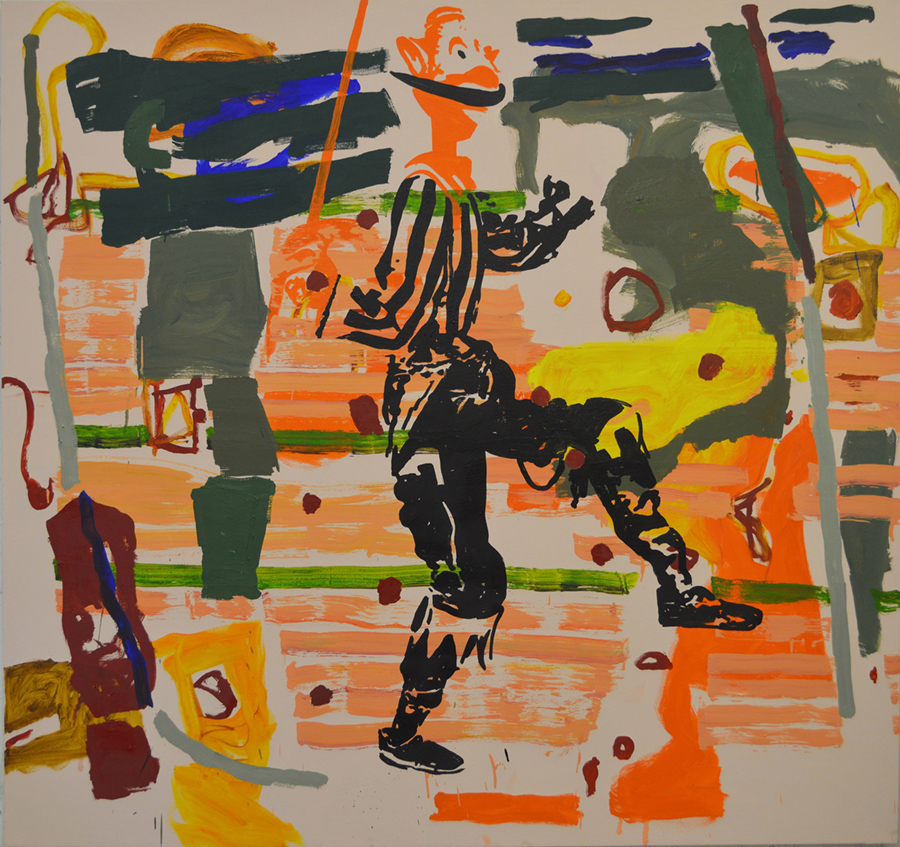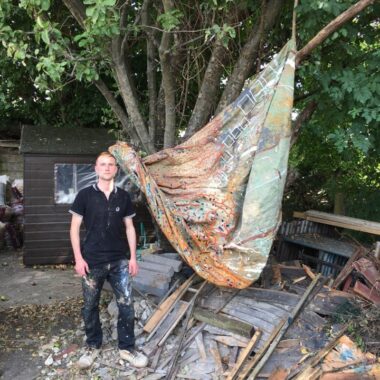With a playful introduction by Michael Phillipson LG
An introduction to an extract (Text 20 below) from James Faure Walker’s recent on-line collection “Works in Progress…“
Imagine three eyes, each with REM and a different focus: the first (perhaps the slightly dominant one…) is fixed on painting and its infinitely receding past, present, and future fields; the second focuses, equally fixedly, on the computer’s ever-shifting pixellations and their possibilities for painting’s life*; the third (possibly Cyclopian and located just below the surface above and behind the others) is completely absorbed in and directed by its focus on language’s open play. Assume too, that the three of them are engaged in continuous, often contentious, exchanges. Then imagine a hand (or two) with a mind of its own, but also with a desperate desire to follow, to the best of its abilities, the eye-triad’s ceaseless instructions. Keeping these firmly in mind (if such is possible…), leap into the extract below: ‘Clowns, Puppets, and not being Abstract’! Finally, you can complete your performance by exploring on-line the remaining 23 Texts-with-images that James published to complement his recent exhibition at Felix and Spear. They appear under the title “Works in Progress, Extracts from a Catalogue: Thoughts on Five Decades of Painting”. If making-for-art and painting engage you you’re in for a treat!
But don’t assume that James’s sense of the title’s ‘Progress’ is caught up in the conflicting interpretations of its current usage. Nor is he allying himself with some, supposedly ‘progressive’, modernist-technicist negation of the past. Rather, consider the ‘gress’ in ‘Progress’ here as pointing back very precisely to its origin in the verb ‘to walk’. It referred precisely to going for a walk, taking the next step: stepping forth – just going on, best foot forward! Isn’t this exactly what one would expect (and hope for…) as the singular aim of a committed walker-painter still in full flow? At Text 18 in “Works in Progress…” you’ll also find a performative punning homophone floating into view via the attached digitally-imaged painting of James Faure Walker’s “Four Walkers”, closely followed by an image of his “Football”. Substitute an ‘f’ for the ‘b’ in the latter and there you have it again! Sometimes a name marks defining qualities of a life-performative: here a walker-swimmer-painter’s streaming on aslant.
Hopefully, you will eventually click to Text 1 and sault your way from text-island to text-island as you follow the currents of James’s acute and often wry written and paint-full tributary. In full spate it journeys through critical moments of his painting-writing performance. He continually reconstitutes the latter in the course of both his engagement with other artists and writers and his enmeshment within the unfathomable complexities of the art-representing machinery. You’ll see that, negotiating the tides and undertow, with brush in hand above the waves, he survives and flourishes. Down the decades something essential is being filtered through to him via the shady eye-triad’s continuous back-room exchanges – the performance-defining necessity of his critical reliance on the interplay of improvisation with an open restless self-questioning.
*The breadth and depth of James’ earlier exploration of the possibilities of painting’s relation to digital imagery can be found in his ‘Painting the Digital River’, Prentice Hall, N.Y., 2006.
Michael Phillipson LG, 2021
20 Clowns, Puppets, and not being Abstract
by James Faure Walker LG
For years I had been trying to balance the demands of painting – constantly invoking its history – with the futurist aesthetic of digital art, which, by the nineties had been rebranded as ‘new media’, was cool, and was taken seriously by institutions; it meant new ‘immersive’ art experiences. At SIGGRAPH the longest queues in the art shows were for the virtual reality exhibits1. In 2001 I saw, or experienced, Olafur Eliasson’s ‘Surroundings Surrounded’ at the ZKM in Karlsruhe. In one piece you walked through rain. I was impressed, but aware that throughout ZKM’s permanent collection were works familiar to anyone who had been going to electronic art festivals. Two or three years later they had served their purpose; they had become instant history, had become abandoned prototypes. A brief moment in the sun. Some doubters had described the phenomenon as ‘demo art’. Elsewhere in the museum complex, in the contemporary art collection, I took more pleasure in the Polkes, if only for their wit. Encountering a painting was stimulating and direct – no user instructions, no headphones, no instant ‘experience’, and it didn’t date so fast. As a painter I was more attuned. However, electronic art was being repurposed for a general audience. I didn’t enjoy the large installation shows. I felt processed, as if in an arty theme park.

I was pleased to have been to Karlsruhe. I was taken by my gallerist, Wolfgang Lieser, whose DAM Gallery in Berlin has been invaluable in charting the early years of computer art. There was clearly a dividing line – and it suited institutions – separating the digital and the painterly. Putting them together brought a clash of values, and different audiences. In a souvenir shop I spotted a toy car driven by a clown, and took a photo. It appealed to me, and back home I had a place for it in a large composition. Later, I wondered whether it reflected my true feelings. I called it ‘Portrait of the Artist Excited by New Technology’.
Clowns, in the form of puppets, reappeared some years later. In 2017 I was on holiday in Palermo, and on the recommendation of John McLean, made a point of visiting the puppet museum (Museo Internazionale delle Marrionette). If the Great Barrier Reef is one of the wonders of the natural world, this is one of the wonders of the museum world. Being surrounded by so many grotesque, grimacing, exotically costumed models was unsettling. It was an overwhelming barrage of hilarious colour, grabbing and pulling you this way and that. I began taking photos. There was one room in particular. The puppets were half-life-size circus clowns, part of Vittorio Podrecca’s travelling troupe, the ‘Theatre of the Little Ones’, which performed internationally for some thirty years after 1923. I was fascinated by the shapes. I wondered what I might be able to do with them.
The first of these paintings I designated again as a self-portrait, without much reason. The key was the moustache. Three others followed, including ‘Voyager’, riding a penny-farthing, and ‘Bob’. I had been struggling for some months with the image of Bob in digital form. He was confrontational with his outsize bow-tie. In the end he crept into a painting, which, unusually, I completed in one day.
I have exhibited these, but so far no-one has asked me what the clowns are up to. In studio shows some questions never get asked. General questions, yes – what is it about? – but rarely anything specific. We are conditioned to be respectful – usually. Abstract paintings invite just a glance, or a pious silence, and when ‘images’ float in, well, it can be confusing. I once exhibited an eight foot wide painting full of images transcribed from an 1880’s how-to-draw book. What I thought to be an obvious leg occupied the middle. It had been selected for a SPACE fifty-year anniversary exhibition. At the opening, a gala occasion, I found it had been hung upside-down. I mentioned this to the person invigilating the room, but he assured me the curators had known what they were doing, and that the artist was an abstract painter. I then pointed out the images to the gallery director, and had the satisfaction of seeing the painting taken down and put back the right way, amidst all the VIP guests.

Would I have found my way to this mixture of playful shapes and figures without discovering computer graphics? There is nothing original in that. It is there in later Cubism, Picasso, Leger, and in Klee, Rauschenberg, Kitaj, New Image, and Neo-Expressionism…. You name it. I had exhibited a large painting of acrobatic cut-out figures in 1987, but soon discarded it. The difference now was that the technical process of seeing something interesting and slipping it into a painting was easy. I had full control over the process. I did not have to use found photos.
This in-between territory appeals to me, where it doesn’t matter whether a form is just a shape or a leg. It can be troubling in a free-form abstract painting to find a dog’s face appear, or a striding figure. This way the improvisation can be the background, while the foreground – a face, a bird – takes care of itself. For a composition without images I can direct the eye using similar devices. I have done tests, seeing how low the resolution can be in terms of dots per square inch, so as to be able to read a dancing figure. It was much cruder than I expected. You need so little information because the mind fills in what’s missing.
One of my favourite landscape painters is Philips Koninck. To read the distances in his panoramas, toy figures are placed at key points on the winding paths that lead towards the horizon – always set low under a huge sky. There is an anecdote in Reynolds’ ‘Discourses’ where there is confusion about what the word ‘figure’ meant in a landscape. It is easy to forget – when so much writing on art dwells on how you read a portrait, on the human interest – that figures only have bit parts in landscape painting. The figures are just pictorial devices.
James Faure Walker LG, 2021
www.jamesfaurewalker.com
1 I had written about the early VR works in 1995 in ‘The Outside/Inside of Techno Art’, Mute, Winter
Text 20 Clowns, Puppets, and not being Abstract is an extract from ‘Works in Progress, Extracts from a Catalogue: Thoughts on Five Decades of Painting’, produced to accompany my exhibition of paintings of the seventies and eighties at Felix and Spear this summer. It is available (free) as an eBook at James Faure Walker: Works in Progress









